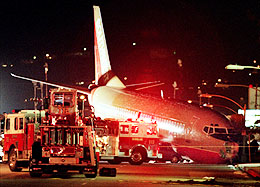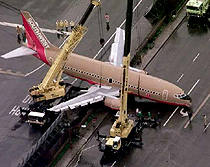
A Southwest Airlines Boeing 737 Skids Of Runway And Comes To A Stop On Hollywood Way
Dallas--March 5, 2000--Southwest Airlines flight 1455 - a flight from Las Vegas to Burbank - ran off the runway at Burbank International Airport this evening. Flight 1455 touched down at Burbank International Airport shortly after 6:00 p.m. PST upon arrival from Las Vegas. The Boeing 737 slid off the wet pavement, broke through a barrier at the end of the runway and came to a stop on Hollywood Way a few yards from a gas station. No fatalities or serious injuries reported at this time. Local authorities and medical personnel have ended to all of the 137 passengers onboard. Southwest Airlines personnel at the Burbank airport are working with passengers and families to make any necessary accommodations.
It is not certain at this time why the aircraft was not able to stop
upon its landing in Burbank. The last maintenance check was performed on
March 2, 2000. The flight crew was on their first trip of the day. While
crew names are not being released at this time, it is known that the captain
has been with Southwest Airlines for more than ten years and has accumulated
several thousand hours of flight time on the 737. ![]() View
Video
View
Video
March 7, 2000, National Transportation Safety Board Chairman Jim Hall today issued the following statement on the Board's investigation of the accident involving Southwest Airlines flight 1455:
n Sunday, March 5, at approximately 6:11 p.m., PST, a Southwest Airlines Boeing 737-300, operated as flight 1455 from Las Vegas, Nevada, overran the departure end of runway 8 while landing at Burbank, California. The airplane traveled through a fence and came to rest on a highway outside the airport perimeter. There were no fatalities to the 137 passengers and 5 crew aboard.


The Safety Board immediately dispatched a team of investigators from its regional office in Gardena, California and its Washington, D.C. headquarters. Safety Board investigators in Burbank are heading up groups in the areas of flight operations, air traffic control, aircraft performance, aircraft structures, aircraft systems, and survival factors. Additional investigators are working from Washington in the areas of meteorology and airport factors.
Both the cockpit voice recorder (CVR) and the flight data recorder (FDR) were transported to the Board’s laboratory in Washington and have been read out by Safety Board engineers. Today the NTSB established CVR and FDR groups chaired by Board investigators with representatives of the Federal Aviation Administration, Southwest Airlines, Southwest Airline Pilots Association, and the Boeing Company.
The following is preliminary information that the NTSB has gleaned from the CVR, FDR, recorded radar data, and input from air traffic control personnel:
-
The CVR recording is of good quality with 31 minutes and 35 seconds of information. The FDR has good information on 30 parameters.
-
Upon initial contact with air traffic approach control, flight 1455 was advised to expect landing on runway 8.
-
Approach control asked the flight to maintain 230 knots or greater until advised.
-
After subsequent heading and altitude assignments, approach control cleared flight 1455 for a visual approach to runway 8 with a restriction to remain at or above 3,000 feet (above mean sea level) until passing the Van Nuys very high frequency omnidirectional range (VOR) beacon. This navigational aid is approximately 6 miles from the runway.
-
Radar data suggest that the flight began its descent from 3,000 feet about 4 miles from the runway. FDR data suggest that the flight's descent angle from 3,000 feet to touchdown was in excess of 6 degrees. In comparison, the flight path angle for the instrument landing system for runway 8 at Burbank is 3 degrees.
-
The crew was cleared to land by Burbank Tower and also advised that the wind was from 210 degrees at six knots. This is consistent with FDR data, which suggest a tailwind component at the surface of less than 5 knots.
-
During the final descent, there were annunciations from the airplane's ground proximity warning system of "sink rate" and "pull up." Engines remained at low or idle power settings through this period.
-
According to the FDR the airplane's speed at touchdown was approximately 181 knots.
First indications of an impact were about 20 seconds later. The airplane was traveling at about 32 knots at the time of this impact.